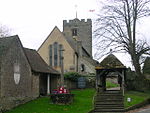Upper Arun
Sites of Special Scientific Interest in West Sussex

Upper Arun is a 17.6-hectare (43-acre) biological Site of Special Scientific Interest between Billingshurst and Pulborough in West Sussex.This 13-kilometre (8-mile) long stretch of the River Arun provides the habitat for a rich riverine flora, such as common club-rush and reed canary-grass. It is an outstanding site for breeding dragonflies, including the clubtail, hairy, brilliant emerald and the nationally rare scarce chaser.
Excerpt from the Wikipedia article Upper Arun (License: CC BY-SA 3.0, Authors, Images).Upper Arun
Toat Lane,
Geographical coordinates (GPS) Address Nearby Places Show on map
Geographical coordinates (GPS)
| Latitude | Longitude |
|---|---|
| N 50.988 ° | E -0.514 ° |
Address
Toat Lane
Toat Lane
RH20 1BZ
England, United Kingdom
Open on Google Maps









